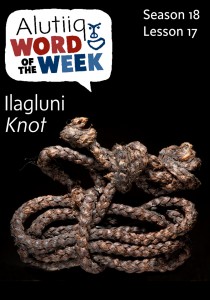 Ilagluni – Knot
Ilagluni – Knot
WiRafkuuq ilag’ngauq. – The rope is knotted
The Alutiiq verb for tying a knot–Ilagluni–is related to terms used for tangled, confused, or impassable. The sentence WiRafkuuq ilag’ngauq can mean either that a rope is secured with a knot or that it is tangled.
In classical Alutiiq society, sturdy, knotted ropes, cords, and lines were essential parts of many common tools. People secured harpoon points to shafts with twined cordage, towed sea mammal carcasses home with ropes tied to their kayaks, hunted birds with braided nooses, tied nets from nettle fiber, and retrieved fish from the ocean floor with hooks secured to long lines. In their homes, people suspended gear from the rafters with line, tied seal stomach containers closed to hold oil and plant foods, carried baskets with braided handles, and used cords in manufacturing clothing and jewelry.
Making line was a job undertaken by women, and one of the tasks little girls practiced. Historic accounts suggest that Alutiiq ladies preferred whale sinew for cord, but archaeological finds suggest that they also manufactured cords of grass, spruce root, and baleen. Fragments of these lines show that people created both three and four string braids, and that they used a box stitch to make sturdy lanyard-like cords.
Knotted fibers not only tied tools together, they helped repair broken items. An ancient water scoop, from Karluk illustrates this technique. A hole drilled in each side of a crack in the scoop allowed a craftsman to tie the crack shut with thin strips of baleen.
